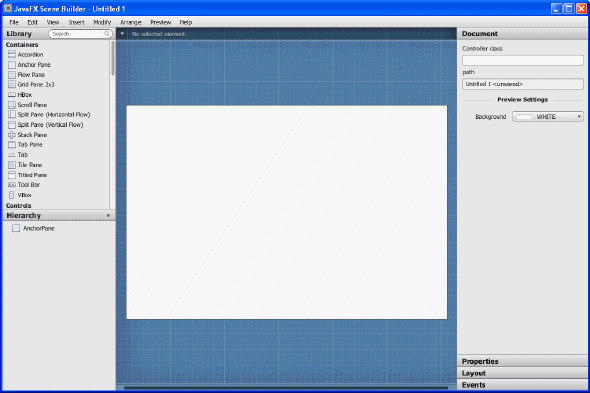FX Experience Has Gone Read-Only
I've been maintaining FX Experience for a really long time now, and I love hearing from people who enjoy my weekly links roundup. One thing I've noticed recently is that maintaining two sites (FX Experience and JonathanGiles.net) takes more time than ideal, and splits the audience up. Therefore, FX Experience will become read-only for new blog posts, but weekly posts will continue to be published on JonathanGiles.net. If you follow @FXExperience on Twitter, I suggest you also follow @JonathanGiles. This is not the end - just a consolidation of my online presence to make my life a little easier!
tl;dr: Follow me on Twitter and check for the latest news on JonathanGiles.net.
by Jonathan Giles | Apr 8, 2012 | Links
How’s it going everyone? This is Carl Dea (@carldea) filling in for Jonathan Giles who is/was presenting at JavaOne in Tokyo, Japan. Below are this week’s links of the week. The links aren’t in any particular order except for the first one which is about the amazingly cool Scene Builder tool.
- Richard Bair (chief architect for the Client Java Platform at Oracle) happily shares the good news about the very cool Scene Builder tool announced during the keynote at JavaOne Tokyo Japan. Here is Oracle’s official site to download the preview release.
- William Antonio discusses his first impressions of the latest preview release of the Scene Builder Tool.
- Halfway around the globe Jonathan Giles managed to present at JavaOne and interview Java Champions Jim Weaver and Stephen Chin. (Jonathan’s from the future) 🙂
- Manoj Debnath blogs about Animation in JavaFX vs. Flash. Manoj only details JavaFX 2.x and mentions little of Adobe Flash to contrast the two technologies.
- Java Champion Joshua Marinacci asks kindly if you are a GUI designer or Developer to please take Leonardo Sketch out for a spin (test). Leo Sketch is a full featured vector drawing tool very much like a scene builder tool. I believe the new JavaFX 2 FXML export feature may be available (ask him). It is a great tool for mocking screens, presentations, and more.
- A nice book review by Jason Lee on the recently released book “Pro JavaFX 2: A Definitive Guide to Rich Clients with Java Technology”
- Java-Buddy (mystery person) creates easy to follow tutorials. Java-Buddy begins to create an app to free draw using the mouse, and a set of tutorials to transform shapes using rotation, translation, scale, and shear.
- The JavaFX teams released a recent developer preview build of JavaFX 2.2 build b03. It’s nice to see it available for all the major platforms (Windows, MacOS, and Linux). Be on the lookout for the release notes for all the hard work that has been done.
- Narayan has blogged about form field validation using CSS styling.
- introjava (aka Gregg Setzer) has posted a Ribbon control to his blog. It would be nice to see this in JFXtras at some point soon!
Well, that’s it for this week I hope you enjoyed the links (I sure did). Keep up the great work! I want to thank Jonathan for allowing me to share with you all about the possibilities on the Java platform especially on the desktop.
-Carl

by Jonathan Giles | Apr 5, 2012 | Interviews
Hi all. I’m currently sitting in a hotel room in Tokyo, but I’ve been waiting to publish this interview until Jim and Steve made their announcements this week. Now that the news of their employment at Oracle is out, here is the interview. Enjoy! 🙂
Hi Jim and Stephen, would you please introduce yourselves?
Jim: Hi Jonathan, I’m Jim Weaver, long-time application developer with a particular interest in rich-client Java/JavaFX development.
Steve: I am also a JavaFX client hacker and enjoy working on several different open-source projects related to this.


You’ve both been involved with JavaFX for a long time. What drew you into JavaFX in the first place, and what keeps you going with it?
Jim: Rich-client development should be simple and elegant, but the post-1994 trend has been to force-fit the browser into being an application execution environment. Consequently, many rich-client applications are comprised of Rube Goldberg machine-esque combinations of HTML, JavaScript, XML and other technologies. JavaFX is an elegant and powerful technology for creating rich-client applications that run on the Java Virtual Machine (JVM).
(more…)

by Richard Bair | Apr 3, 2012 | FXML, JavaOne, News
 Hello from JavaOne Japan, where Jasper, Jonathan and I find ourselves seated in the opening keynote of the morning. One of the big announcements is the public beta of the JavaFX Scene Builder, our new tool for laying out and creating JavaFX content. The Scene Builder is the start of a more comprehensive RAD (rapid application development) tool for JavaFX, with drag-and-drop GUI building and eventually data binding.
Hello from JavaOne Japan, where Jasper, Jonathan and I find ourselves seated in the opening keynote of the morning. One of the big announcements is the public beta of the JavaFX Scene Builder, our new tool for laying out and creating JavaFX content. The Scene Builder is the start of a more comprehensive RAD (rapid application development) tool for JavaFX, with drag-and-drop GUI building and eventually data binding.
(more…)
by Jonathan Giles | Apr 3, 2012 | Links
Hello everyone! This is Carl Dea (@carldea) and I am filling in for Jonathan who is currently at JavaOne in Tokyo, Japan. This has been a busy week in the JavaFX community. Here are this week links.
(Note from Jonathan: Thanks to Carl for stepping up to the plate for this week and next week. You really should consider buying his book).
- JavaFX 2.1 build b19 Developer Preview Download is available!
- Stephen Chin has released his slide presentations from the 33rd Degree Conference. One of the slide presentations discusses developing JavaFX 2.x applications using the Scala language titled “JavaFX 2 and Scala – Like Milk and Cookies“. The other slide presentation covers the development of cleaner APIs and better UIs on the JavaFX 2.x platform using the Visage language.
- (Late breaking link from Jonathan): Speaking of Stephen and Jim, they have just announced that they are joining the Java envangelism team at
NASA Oracle. Stephen has blogged about this both on, and fortunately after, April Fools Day. I’ve got an interview lined up with them that I’ll publish here at FX Experience in the coming weeks.
- Chika Okereke has blogged about a PDF to JavaFXML conversion using a technique which applies CSS styles to JavaFX 2.x graph nodes dynamically using the @FXML annotation.
- Bertrand Goetzmann has shown off a screen cast demonstrating an application he is working on called Metaphora (source code). He has made use of GroovyFX and Netty which are two powerful combinations (A graphics DSL handling file transfers with non blocking I/O).
- Jonathan Giles has continued with his series of interviews with key software engineers at Oracle. Jonathan has interviewed Jeff Hoffman and David Grieve. Jeff is a lead user experience developer who has the very huge responsibility of the end-to-end deployment experience. David is an engineer on the UI controls team who is (a hero imo) behind JavaFX’s CSS support. 🙂
- The Java Spotlight episode 76 podcast has interviewed authors James Weaver , Weiqi Gao , Stephen Chin , Dean Iverson, and Johan Vos (The Dream Team) to talk about their recently published book, Pro JavaFX 2. This interview highlighted separate areas of the book which were crafted by each individual author’s unique expertise.
- Also, at Java.net Johan Vos explains about ways to handle dependency management using Maven when using the DataFX artifacts. He also asks the community for feedback on the preferred way involving JavaFX. I’d like to see Gradle in the picture with transitive dependencies set (sorry couldn’t resist).
- Dan Zwolenski blogs about Spring Security and JavaFX. He shows you how to integrate the Spring framework to authenticate and authorize access in a JavaFX application.
- I recently blogged about the creation of a spaceship game using JavaFX 2.x. as Part 1 of a series of tutorials which will incrementally take you through the game development process. Here I basically demo the way I want the spaceship to navigate.
- The Griffon Framework has now released the JavaFX plugin which allows writing Griffon JavaFX applications by using GroovyFX to code views. Griffon also has a new JavaFX archetype to create a simple JavaFX Griffon application in seconds.
- Java-Buddy (a blogger whose name is still a mystery to me) has created quick and simple tutorials on how-to execute JavaScript in WebView from Java code and how-to embed Google Maps in JavaFX WebView.
- Anton Epple blogs about a nice looking JavaFX 2.x version of the popular game Tetris. I hope to see him make it even better. He mentions about some audio issues. Hopefully he can file the issue on Jira so that it can be followed up.
- Wichit Sombat creates a bunch of videos this week where he walks you through tutorials on How-to create bouncing icons, a docking application, setting up IntelliJ IDEA for JavaFX, and getting started on JavaFX on Ubuntu.
- Tom Schindl publishes his slide presentation on e(fx)clipse, the Eclipse Tooling and Runtime for JavaFX.
- Dilip has a very cool blog entry and tutorial that will help you get started with JavaFX with JBox2D (the very cool physics library).
That’s it for this week everyone. Keep up the great work and keep those creative juices flowing!

by Jonathan Giles | Mar 28, 2012 | Interviews
This interview is with a team mate of mine – David Grieve. As you’ll discover in this interview, he has been involved with JavaFX for a long time. I won’t spoil any more of the interview – so enjoy and feel free to leave comments in this blog related to JavaFX CSS support.
One small note: I will be away at JavaOne Japan for the next two weeks, so it is likely I won’t publish any more of the interviews I have until I get back. Now, on with the interview! 🙂
 Hi David. Could you please introduce yourself to everyone?
Hi David. Could you please introduce yourself to everyone?
I’m a graduate of the University of Pittsburgh with a Bachelor degree in Computer Science. I got started in Java in 1997 when I helped develop a Java-based network-management tool. Since then, I’ve been programming almost exclusively in Java. On the personal side, I live in New Hampshire with my wife and our two children.
You’ve been in the JavaFX controls team longer than I have – how long have you been working on JavaFX?
I’ve been working on JavaFX since 2008 when I led the development of the Media Browser tutorial which was part of the 1.0 effort. I became part of the UI controls team around the start of the 1.2 development cycle. I took on the development of CSS at that time, which would have been March, 2009, if I recall correctly. It all seems so long ago.
As long as I’ve known you, you’ve always worked on CSS support in JavaFX. Firstly, I must thank you – CSS in JavaFX is wonderful.
Thanks! But a lot of the credit has to go to Richard and Jasper who set the direction. Concepts that really make JavaFX CSS powerful – such as color derivation, property lookup, and multiple background colors and borders – come from them. I just put the code together to make it all work.
(more…)

by Jonathan Giles | Mar 26, 2012 | Interviews
Today I have an interview with Jeff Hoffman, a member of the Java team at Oracle. Enjoy the interview!
Hi Jeff – could you please introduce yourself to the readers?
Jeff Hoffman, I’m the lead user experience developer for Java at Oracle.

You’re a member of the Java team at Oracle, but what is it that you actually do in general?
I work closely with the Java team members who are creating anything that will eventually be seen by an end user. I cover the end-to-end deployment experience from the java.com website where most users get Java on their computer to the launch sequence for an applet or web start application. This is where I have the largest impact since install, update and application launch processes have a lot of end user visible components. Much of my focus these days has been on the impact that our security measures have on application launch — specifically the dialogs we show when an application is requesting elevated permissions.
(more…)
by Jonathan Giles | Mar 25, 2012 | Links
Welcome folks to another weekly roundup. Keep up the great work everyone! 🙂
- Build 18 of the JavaFX 2.1 Developer Preview release is now available for download. We are getting a long way down the release cycle now.
- The Asia-Pacific Virtual Developer Day is coming up tomorrow. Attend to learn about JavaFX and what is new in Java 7. I’ll be there providing support.
- Angela Caicedo has posted a video about how to get started using the Scene Builder tool. This is your first chance to see it in action.
- Tom Schindl has released e(fx)clipse 0.0.13, which includes a bunch of new stuff.
- I started a series of interviews with people inside and outside of Oracle who are all members of the JavaFX community. In the past week, I published interviews with book author Carl Dea, and SteelSeriesFX developer Gerrit Grunwald. I have more interviews to publish in the coming months.
- Speaking of Carl Dea, he was also interviewed by Nicolas Lorain about his recently released JavaFX 2 book.
- Eric Bruno has blogged about simple searching in JavaFX (using a TextField to filter a ListView).
- Hugues Johnson has created a file browser demo application. I would like to add that he says the sample in the TreeItem JavaDoc (which I wrote) builds up the entire directory structure recursively at startup. This is incorrect – the sample actually builds the tree structure on-demand.
- Dan Zwolenski has published three posts this week. Firstly, about adding database support to a JavaFX application, secondly about adding search support, and finally about software logging.
- introjava blogged about working with JavaFX 2 layouts, and also working with JavaFX 2 linear gradients.
- Josh Marinacci has split out his AppBundler project out into its own Github repository. AppBundler is an Ant task for packaging up desktop Java apps as native executables. He mentioned to me that he is on the lookout for contributors who could help with JavaFX, OpenJDK embedding, and Linux support.
For the next two weeks I’ll be in Japan, but these posts will be continuing thanks to a guest poster I’ll introduce next week.

by Jonathan Giles | Mar 22, 2012 | Interviews
It’s time for another interview, this time with Gerrit Grunwald, or hansolo_ as he is known on Twitter. Gerrit has been in my weekly desktop links posts dozens of times, each time relating to his work on his SteelSeries project, which is a collection of gauges and other UI components for Swing. Even better, he has started working on JavaFX versions of these controls, and this is why I am please to be interviewing him today.
Briefly, in other interview news, I’m lining up a number of other interesting people, both inside Oracle and from the community. I’ll put these interviews out over the next few months, at a rate of one or two a week I imagine.

Hi Gerrit – could you please introduce yourself to everyone?
I’m working as a software developer at Quintiq GmbH in Germany where I’m responsible for visualizations of all kinds. I’m really in love with Java Desktop and I’m addicted to custom controls of all kinds because it’s pure fun. I founded the Java User Group in Münster (Germany) where I’m living and my heart beats for the community.
You’re a relative newcomer to the JavaFX world, joining around the release of JavaFX 2.0. What drew you into JavaFX?
I tried JavaFX in the early days when it even was not JavaFX but F3 and liked the concepts but somehow JavaFX Script was not made for me which kept me away from using it. When Oracle announced JavaFX 2.0 and I saw the implementation in pure Java I started another try and got infected. Now after using JavaFX 2.x for some months I just can say…I LOVE IT.
(more…)

by Jonathan Giles | Mar 19, 2012 | Interviews
I’m slowly trying to get more interviews up on this site, as I think it is really informative to learn what your peers are doing and thinking about a platform. The following interview is with Carl Dea (whom I’ll let introduce himself in a few lines). I know Carl from JavaOne 2009 where we shared a hotel room for the week, as we had both won tickets to the conference (this was slightly before I joined Sun), and we spent the time going between the various Java desktop sessions and meeting people we’d only previously known online. It was an incredibly fun time!
Also, before I begin the interview, I also wanted to quickly wanted to note that Carl was also interviewed by Nicolas Lorain for the Oracle Author Podcast (Direct MP3 download). With that done, here is the interview. Enjoy! 🙂
![carl_avatar2[1]](http://fxexperience.com/wp-content/uploads/2012/03/carl_avatar21.png)
Hey Carl, would you please introduce yourself?
I am the co-author of the book Java 7 Recipes, author of JavaFX 2.0 Introduction by Example, and the technical reviewer of the recently released Pro JavaFX 2 A Definitive Guide to Rich Clients with Java Technology from Apress publishing. For my day job I am a Senior Software Engineer for BCT-LLC. By night I am a Java/JavaFX and Rich Client enthusiast who blogs at CarlFX.
You’ve been involved in the JavaFX world for a long time? What drew you into it?
I have been involved with JavaFX from the beginning when it was called F3 (Form Follows Function) created by Chris Oliver which eventually had been acquired by Sun Microsystems (now Oracle corp). What drew me into JavaFX was the fact that in the beginning JavaFX 1.x was a graphics language (DSL) capable of combining lower level graphics drawings, user interface controls, media, and animation capabilities with very little effort. At the time as a Java Swing developer I found that building a UI application was a pretty challenging task, so I resorted to using framework libraries to build well behaved UIs. To my surprise JavaFX 1.x seemed to be a natural step in moving Java on the desktop forward. So, I continued to boldly go where no Cobol developer has gone before.
(more…)
by Jonathan Giles | Mar 18, 2012 | Links
Welcome to yet another week of JavaFX links. I hope you’re all doing well, and that you find something of interest in this weeks roundup.
- The JavaOne call for papers has opened up, and closes mid-April. It is time to get your sessions submitted! Hopefully I’ll get to go along again and will see you all there again (and continue the tradition of the Java Desktop lunch).
- It’s not until late April, but you’re not going to want to miss the introduction to the JavaFX Scene Builder tool, being given by Nicolas Lorain (PM for JavaFX) and Jasper Potts (Developer Experience Architect for JavaFX). This is at the Silicon Valley JavaFX User Group, but as always you can attend virtually and join in the live webcast.
- Michael Heinrichs, a developer in the JavaFX team at Oracle, has explored the JavaFX CSS functionality, something he admits he was not involved in developing, and comes away pleasantly surprised by how well it works. Considering this is something my team ‘owns’, I’m very pleased he is happy (but all praise should be directed at David Grieve, the long-standing owner of all CSS functionality in JavaFX).
- Kumanivasar Srin has posted a JEP over at the OpenJDK to add support into Java to make it support loading JavaFX applications without any special compilation needed. This would be a great thing to get into Java in my humble opinion.
- Willy Raharjo has posted two blog posts about JavaFX and Slackware. The first post is a tutorial on running JavaFX apps on top of Slackware. The second post discusses integrating JavaFX into Netbeans on top of Slackware.
- PFGrid has released a first version of their (commercial) PFGrid FX toolkit, which at this stage contains just one control: a ‘rotator’ control.
- I did a blog post introducing the new ComboBox control in JavaFX 2.1. In general it should be a very useful control in your toolbox.
That’s that for this week. Catch you again next week.








